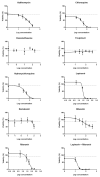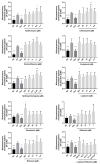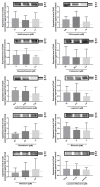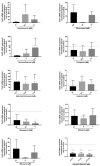Effects of Drugs Formerly Proposed for COVID-19 Treatment on Connexin43 Hemichannels
- PMID: 35563409
- PMCID: PMC9103705
- DOI: 10.3390/ijms23095018
Effects of Drugs Formerly Proposed for COVID-19 Treatment on Connexin43 Hemichannels
Abstract
Connexin43 (Cx43) hemichannels form a pathway for cellular communication between the cell and its extracellular environment. Under pathological conditions, Cx43 hemichannels release adenosine triphosphate (ATP), which triggers inflammation. Over the past two years, azithromycin, chloroquine, dexamethasone, favipiravir, hydroxychloroquine, lopinavir, remdesivir, ribavirin, and ritonavir have been proposed as drugs for the treatment of the coronavirus disease 2019 (COVID-19), which is associated with prominent systemic inflammation. The current study aimed to investigate if Cx43 hemichannels, being key players in inflammation, could be affected by these drugs which were formerly designated as COVID-19 drugs. For this purpose, Cx43-transduced cells were exposed to these drugs. The effects on Cx43 hemichannel activity were assessed by measuring extracellular ATP release, while the effects at the transcriptional and translational levels were monitored by means of real-time quantitative reverse transcriptase polymerase chain reaction analysis and immunoblot analysis, respectively. Exposure to lopinavir and ritonavir combined (4:1 ratio), as well as to remdesivir, reduced Cx43 mRNA levels. None of the tested drugs affected Cx43 protein expression.
Keywords: COVID-19; cellular communication; connexin43; drug; hemichannel.
Conflict of interest statement
The authors declare no conflict of interest.
Figures




Similar articles
-
Effects of Drugs Formerly Suggested for COVID-19 Repurposing on Pannexin1 Channels.Int J Mol Sci. 2022 May 18;23(10):5664. doi: 10.3390/ijms23105664. Int J Mol Sci. 2022. PMID: 35628472 Free PMC article.
-
Blocking Connexin-43 mediated hemichannel activity protects against early tubular injury in experimental chronic kidney disease.Cell Commun Signal. 2020 May 25;18(1):79. doi: 10.1186/s12964-020-00558-1. Cell Commun Signal. 2020. PMID: 32450899 Free PMC article.
-
Circadian coordination of ATP release in the urothelium via connexin43 hemichannels.Sci Rep. 2018 Jan 31;8(1):1996. doi: 10.1038/s41598-018-20379-0. Sci Rep. 2018. PMID: 29386573 Free PMC article.
-
Insights into antiviral mechanisms of remdesivir, lopinavir/ritonavir and chloroquine/hydroxychloroquine affecting the new SARS-CoV-2.Biomed Pharmacother. 2020 Nov;131:110668. doi: 10.1016/j.biopha.2020.110668. Epub 2020 Aug 24. Biomed Pharmacother. 2020. PMID: 32861965 Free PMC article. Review.
-
Protein kinase C-dependent regulation of connexin43 gap junctions and hemichannels.Biochem Soc Trans. 2015 Jun;43(3):519-23. doi: 10.1042/BST20150040. Biochem Soc Trans. 2015. PMID: 26009201 Review.
References
MeSH terms
Substances
Grants and funding
LinkOut - more resources
Full Text Sources
Miscellaneous

